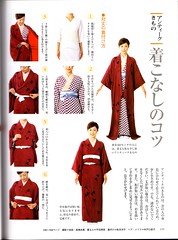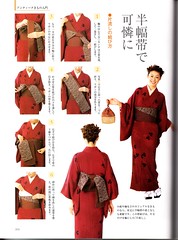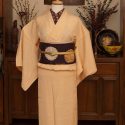Part I – Shop Smart
The subtitle of this blog, as you may have noticed, is A giantess’ adventure in tiny vintage silks. What you may not be aware of though, is how giant I really am. The photos I post are typically alone, and don’t offer much to scale against. I’d like to take a few entries to discuss the challenges of size in the hobby of kimono, since one of the regular excuses I hear for awkward or sloppy kitsuke is “Oh, I’m too big” or “Oh, I’m too curvy.” This first entry will focus on the kimono themselves, and shopping smart.
To start off, how big are we talking here? I am five feet ten inches tall. That’s 1.78 metres. I weigh roughly 175 pounds, or 79 kilos. My bust measurement is a cumbersome 46″ (117cm) around at the widest part. My bra size is currently averaging a 34F, though I recently bought a bra in a G-cup. Yes, you read that right. My waist is a reasonable 28″ (71cm) or so, and my hips are just passing the 40″ (104 cm) mark currently. My inseam when purchasing jeans is just over 35″ (89cm) high, from floor to groin. While this sounds like a figure most women would kill for (tall, long legs, big bust, small waist, rounded hips) it s by far the worst possible scenario for kimono.
So how then, do I manage to pull off wearing garments from a country where the modern national height average for women is 5’2″, or 1.58m, and a bra cup size of B is considered “large”?
The first, and easiest answer is to “buy big”. Modern everyday kimono are being made larger, to accommodate the fact that even women in Japan are significantly taller and wider than they were 50 or 100 years ago. However, this is not always an option, especially if you’re looking at older, one of a kind pieces. My best advice for this would be “don’t compromise.” That Taisho-era piece at a great price is still not a worthwhile investment if it’s so narrow at the hips that you can’t walk in it. If you truly have your heart set on vintage pieces, try looking for hikizuri – kimono meant to be worn trailing by either brides, geisha, or stage performers. Older ones are generally about the right length to be worn “normal style” by taller, modern women. In this outfit, I am wearing a vintage bridal hikizuri, which should have been worn without a fold at the waist and left trailing behind me. However, it’s just the perfect length for me to fold and wear normally.

When buying a kimono, the length should be the same as your height, the wingspan should be from wristbone to wristbone, and the hip wrap should be your own hip measurement multiplied by nearly 1.5 to get a full hip-to-hip overlap. Since I know there is no way I will ever accomplish this, I aim for kimono a minimum of 60″ or 150cm long, a wingspan of 50″ or 127cm, and a hip wrap of 45″ or 114cm. There is no sure set of measurements that are acceptably “too small”, it’s always going to relate to how comfortable and familiar you are with kimono to begin with, but for me, those dimensions are workable.
With tall height comes the all-important question – is ohashori truly necessary, if you find a kimono that’s wide enough but possibly too short? Nowadays, especially when it comes to wearing vintage pieces, the general consensus is that it’s not entirely necessary, especially for casual, everyday wear. So long as the rest of your kitsuke is entirely impeccable, and you’re ready and willing to back up and explain that it was a conscious descision, very few people (aside from perhaps notoriously fussy author of the Book of Kimono, Norio Yamanaka) are going to fault you.
Naomi has taken the time to scan some wonderful instructions on how to put on a kimono that is too short for full ohashori. Please click the small images for a link to her Flickr, where the full-sized ones are contained.


So there you have it – even Japanese kitsuke books are giving explicit instructions on how to dress, proving it’s not vital. Personally, I would not feel comfortable in a formal kimono (anything above an iromuji & fukuro obi combo) with no ohashori, but for everyday wear or going out to a casual dinner, it’s perfectly fine! A well-fitting kimono is ideal, but that’s no reason to leave things in the back of your closet or tansu. Work with what you’ve got! As soon as I get a few things in the mail I am going to be posting an outfit I’ve got planned out with a too-short kimono.
Since this is the first entry in a series, feel free to leave suggestions on how you accommodate a larger figure, or mention other things you’d like to see me discuss. The next entry I’ve got percolating is going to talk about foundation garments and padding, and why they’re so important.














 Bebe Taian
Bebe Taian CHOKO Blog
CHOKO Blog Gion Kobu
Gion Kobu
It is not super fancy to get the right size bra, especially for women like me who have h cup size and fat around the bust. you have put some right direction and made things easy.
thank you so much for sharing your thoughts and tricks, this makes me feel so much less alone! i’m also quite tall and sometimes during kitsuke lessons i feel like a giraffe. but you’re inspired me to keep doing my best and find longer kimono to wear =^-^=
I am so happy to hear that!
I am 5’7 and wear a 44 DD and 48 inch waist what do I do I would like a furisode
If you can afford it, your best bet would be to have a kimono custom-made. You can find some sellers on Yahoo Japan who will do this, or alternatively you can try contacting Ichiroya (www.ichiroya.com) to see if they can help you out. If this is out of your budget, I’d suggest the best body-shaper you can find, something like a Kymaro or a Spanx smoother as well as a minimizer bra, and then a kimono with a back-span of 30″ or something close to it.
Good luck!
I have similar problems.
I’m 5’10” and I’m a pear plus size.
I wear size 16/18 on top and size 20/22 on the bottom
40 around the bust/36 at the ribcage/38 waist/48 hips/36 inseam
I have no problem wearing a sport bra and an ace bandage to
fix my breasts but I have a horrible time with my hips, as it is
my largest entity. I have found that as you stated, bridal wear
is easiest to wear long; I bought a kimono that was 75″ long
which was excellent for my height but I cant even get it to close.
I can get the collar panels to overlap. That’s it. And I assumed I
was doing pretty good since the back width was 27.25″
Since, many kimono are 24″ back width.
I have a yukata that I bought with a 25″ back width; and it’s strange
that I can get it to halfway overlap — won’t overlap to my other hip, but
about halway. Yet……..this kimono has 2 1/4 inches more
back width and I can’t get the front to close!
*sigh*
Btw. I am working on my weight. Because I want to wear kimono for my
wedding. And I just HAVE to overcome this overlap thing!!!!!!!
Good luck!
If you have the budget – have you considered getting a kimono custom made to fit you? It wouldn’t cost much more than any other custom wedding gown.
Pingback: kimono tsuki » Blog Archive » On Being a Behemoth – Size challenges and how to work with what you’ve got
Wow, and I thought my height of 174cm is difficult enough to work with kimono. But it seems like you’re having even more trouble and still doing such good kistuke. I admire you skills.
Mh, I never tried to work with 60″ kimono, I thought they were way too small for me, but the no-ohashori way could do. Thank you so much, this entry was so inspiring!
I’m really glad to hear that! It always makes me feel sad when people tell me they are too big for kimono, or that they overlooked a piece they really loved because it was too short.
The only thing I’ve resigned myself to never owning is a piece of meisen, I’ve *never* seen one even remotely long enough for me to wear, even without ohashori! Alas!
Hi, I’ve just discovered your page and am so happy! 🙂 I love your website, it’s so professional and polished, but still so friendly!
I’m 5′ 9″, and have all the same problems! A lot of mine are about arm length as well, as my combined wrist-to-wrist armspan is 148–outside of any normal tan-mono, even before you’ve lost more to the seam allowances.
I’ve cheated in many ways, including undoing sleeves to gain extra width and and re-sewing the shoulder seams at an angle from the waist to the shoulder, which I can generally regain about 8-10cm through, as well as a favorite trick of mine, which is to look out for vintage ensemble pieces–a kimono and matching haori. I sacrifice the haori and disassemble it entirely to add extra to the kimono sleeves, and an extra but perfectly matched panel to the waist, which will form the entire ohasori fold for overall length. Obviously this only works on patterned kimono, but if you’re careful you can hide the seam entirely within the pattern (especially stripes and checks). I picked that one up from reading about how they make kimono for sumo wrestlers!
But yes, like you I lament that I’ll never find a fab meisen in my size 🙁 Though again, I’ve cheated and bought ones before now whose design I can’t resist, to turn into haori–doesn’t matter how short they are, as I’m going to turn them back on themselves to shorten them further anyway, and haori have that handy extra insert which you add into the side-seams, which gives a bit of extra width, plus you never really close a haori anyway.
The cheats we have to go to, eh?
Please do more on tall kimono and kitsuke!!
Hello! Thank you so much for the lovely comment! I, too, have ridiculous ape arms and have just accepted that wingspan is hardly ever going to be ideal for me. I am in love with the 4TW kimono from Kimonomachi on Rakuten though, they fit me perfectly even at my current weight of 100+ kilos.
That tip about sacrificing a haori is utterly genius though. I have a couple of matched wool hitoe sets with very basic geometric repeating designs, I’m really tempted to try that out now. It’s definitely the sort of thing that wouldn’t be an obvious jump in the pattern, and since they’re unlined they wouldn’t be too complex to disassemble and reassemble. Thank you!
Pingback: kimono tsuki » Blog Archive » Vintage vibe, modern fit!
Someday I will own a kimono bra, but until then I wrap my chest with an ace bandage and this really seems to help. For some reason I am so self conscious of having the dreaded ‘over-boob.’ Padding too helps quite a bit so sometimes I’ll wear a small towel folded in my lower back area.
Back padding is something I’m sort of lazy about, I admit. It definitely helps get a clean line, and helps the obi not shift around, but I still don’t pad my back or waist as often as I should. ><''
I've actually been thinking of getting a FTM binder top, rather than a kimono bra, but they are not cheap, unfortunately.
I have the same problem, but with slightly different dimensions – I’m 5’7″, and my figure is distinctly pear-shaped – 37-29-41. Finding ways to balance my hips has always been a challenge. I don’t have as much problems finding kimono that are long enough, for me finding a kimono with a wide enough wingspan and hip measurement are the challenge. I’m really interested in seeing your next entry – I’m sure I’ll get some tips!
I’m not sure if you’re familiar with the “kohlin belt around the knees” trick, but it’s a godsend for narrow kimono. In the next entry, I’m going to discuss it.